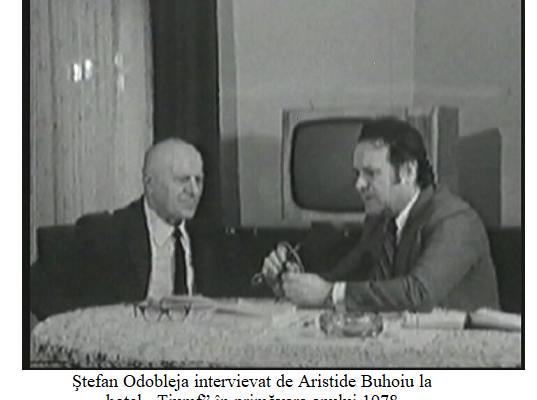Abstract. The subject itself belongs equally to the fields of psychology, art and philosophy. The conceptual boundaries must be established from the onset by defining the two key words included in the title of this paper. The analysis of consonance and resonance in Kandinsky and Odobleja’s works emphasizes the fact that the need for coherence brings them towards searching for a grammar, a language to decode art using the same concepts, by apparently simple means of expression that are in fact complex. The structure and content of the two works we shall refer to, respectively Wassily Kandinsky’s “Concerning the Spiritual in Art” and Ştefan Odobleja’s “Consonantist Psychology”, include similar ideas, resemblances which create the framework of the topic discussed. We highlight certain unique, unusual hermeneutic inquiries concerning art, along with innovative multidisciplinary scientific perspectives. We try to create a virtual, symbolic setting in which to bring the two authors to the attention of the contemporary literature, almost a century later, by means of consonance and resonance.
Keywords: art, aesthetic laws, consonance, harmony, resonance.
CONCLUSIONS
Even though there is no correlation between some clinical or artistic functional criteria, there is a series of connections, coincidences and similarities between the two authors, which are not to be neglected. They both desire our spiritual abilities to be awaken and they both consider that the need for art must belong to a higher level. The need for beauty may become active after the other basic, lower-level needs are satisfied, in part or entirely. It is the only way in which an aesthetic satisfaction can be achieved, when the noetic spiritual threshold of consonance resonates, and these abilities are absolutely indispensable in the future. This paper may be considered an incentive to know them better, to (re)read these books, a simple form of humbleness and homage to the two authors. Daring to admire them is not dangerous at all, even though some
misunderstood them and others even showed open hostility. Kandinsky was aware that he could be considered a theorist justifying his own artistic creation. Odobleja, even during his life, was deeply contested and wronged; he obtained a late academic recognition, post-mortem. In the general conclusions of the “Consonantist Psychology”, the concluding words emphasize that Odobleja’s ideal was to consider things from all points of view, by maximum synthesis and analysis, and that his desire was to create a general plan for the twenty or thirty volumes of a comprehensive “Treatise Of Psychology”. Kandinsky hoped that the echo of his ideas would
not be lost, and they would somehow take roots over time. The great artist stresses in his little book that this consonance or dissonance is not to remain void or superficial, the soul must be maintained in high tones, in harmony, regardless of any obstacles, and art may protect it from any vulgarity. In his view, there are eyes able to see what science is unable to explain nowadays, somehow seeing through themselves there are minds able to synthetize this, and some ideas have unmatched strength. Ştefan Odobleja echoes decades later with an adage: “We do not see with our eyes but with our mind, and if the mind is empty, the eyes look without seeing” (ODOBLEJA, 2020). Consonance and resonance are two concepts which still generate epistemic ambiguities, even among specialists in various fields. These words point to the content of the texts which we refer to and bring together the two authors, in this context, almost a century later. As Kandinsky
and Odobleja noticed, consonance may only be achieved by means of a specific reversible dynamic, through continuous feedback. The consonantist accord calls for resonance itself as
a response. This process is carried out according to certain rules, observing specific laws in continuous interaction. Odobleja goes one step further and explains this process, interaction and feedback laws. Both of them are remarkable pioneers of knowledge. Art is part of their monumental projects; it is vital and defining for Wassily Kandinsky and not at all neglectable for Ştefan Odobleja. Figuratively, their matching ideas and opinions make them consonant, and the echo of consonance and resonance is achieved over time, across real or imaginary boundaries.
We are in their future, and they are part of our past, which we bring into the present. The echo of these ideas brings us the hope that art will always revive, it will find its way once more and retrieve what it has lost.
Reference
FARTHING, S. (2011) The history of art. From cave painting to street art [in Romanian]. Bucureşti: RAO Publishing House.
FRIDE-CARRASSAT, P. & MARCADÉ, I. (2007) Movements in Painting [in Romanian]. Bucureşti: Encyclopaedia RAO. International Journal of Communication Research 407 CONSONANCE AND RESONANCE IN KANDINSKY AND ODOBLEJA’S WORKS
KANDISKY, W. (1994) Concerning the Spiritual in Art [in Romanian]. Bucureşti: Meridiane Publishing House.
LANGEVIN, B. (2012) Children and their drawings. Psychological interpretations [in Romanian]. Bucureşti: Philobia Publishing House.
ODOBLEJA, Ş. (1982) Consonantist psychology [in Romanian]. Bucureşti:Scientific and Encyclopaedic Publishing House.
OPREA, I., PAMFIL, C.G., RADU, R. & ZASTROIU, V. (2009) New UNIVERSAL Dictionary of Romanian Language, Third Edition [in Romanian]. Bucureşti-Chişinău:Litera International Publishing House.
RĂŢOI, T. & ODOBLEJA, Ş. JR. (2020) Dr.Ştefan Odobleja In the Publications of His Time [in Romanian]. Bucureşti:Publicitaria Publishing House.
RĂŢOI, T. & ODOBLEJA Ş. JR. (2018) Ştefan Odobleja. Correspondence. Volume II. [in Romanian]. Drobeta- Turnu Severin: Terra Griphonis Publishing House.
RĂŢOI, T. & ANIŢA C. (2002) Ştefan Odobleja. Correspondence, Volume I. [in Romanian]. Craiova: MJM Publishing House.
ŞĂINEANU, L. (1929) Universal Dictionary of the Romanian language, Sixth Edition [in Romanian]. Bucureşti:Scrisul Românesc Publishing House.
ODOBLEJA (2020) CISO – “Stefan Odobleja” International Conference. Available at: https://odobleja.ro/conferinte/ ciso-curent/ [September 14, 2020].
PLĂVIŢU, C.M. (2020) Art and Aesthetic Laws from a Consonantist Perspective. Children’s Drawings in Connection with the Parental Alienation Syndrome. International Journal of Communication Research. 10(1), pp. 35-42.
DEXONLINE (n.d.a.) Consonance. Available at: https:// dexonline.ro/definitie/consonanță [September 26, 2020].
DEXONLINE (n.d.b.) Resonance. Available at: https://dexonline.ro/definitie/rezonanță [September 26, 2020].



